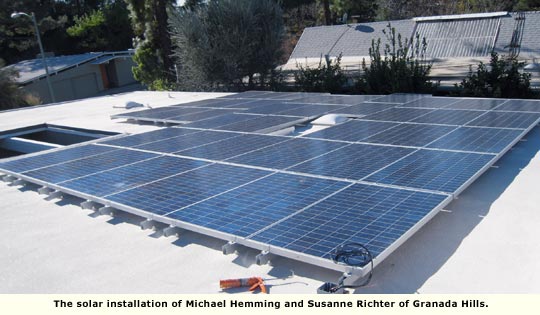Energy: Sun Power Rising - Page 4
Solar providers
There is an array of solar providers in the marketplace, and it can be a challenge sorting out the best from the rest. Quality solar panels typically are installed with 25-year guarantees, and the mounting systems are usually good for 50 or more years. Prior to selecting a dealer and system, it's best to interview at least three licensed California contractors, get bids from each, and do background checks. Reputable solar providers can be located through the Go Solar California Web site (gosolarcalifornia.org), Find Solar (findsolar.com), the California Solar Energy Industries Association (calseia.org), and the Better Business Bureau (bbb.org).
SunPower, a solar system manufacturer based in San Jose, offers a patented all-black solar panel that is as aesthetically pleasing as it gets. The company's 225 and 230 models are reported to be the highest-efficiency solar panels commercially available for residential use. SunPower panels convert an average of 20 to 22 percent of sunlight into energy, compared to 16 to 18 percent of their competitors'. The high efficiency is due to the design of the panels, which feature electrical contacts at the bottom of the panels to increase surface area.
These panels offered by SunPower (with similar results reported from other manufacturers) are 50 percent more efficient than conventional panels, according to Dura-Foam Solar Center's Randy Feriante, whose company is a SunPower authorized dealer. "They look like skylights on your roof when they are installed, and most of the time they are hardly noticeable," Feriante says. "We only need 55 square feet per kilowatt, which is half the size of an average installation."
Akeena Solar, a solar provider since 2001 with offices throughout California, offers a 'plug and play' solar system that is factory-assembled, has a 25-year warranty, and features a dark appearance. The company's flat-roof system can be mounted without penetrations (if local building codes allow it), and it's aerodynamically designed to minimize wind loads. "Generally, no holes or less holes is better for the integrity of your roof," says Gary Mull, vice president of Akeena Solar.
Home Depot teamed up with the manufacturer BP Solar to provide a turnkey way to add solar to the home. Homeowners call the retailer's solar power hotline to schedule a free in-home solar consultation. Home Depot handles the forms and subtracts the rebate directly from the purchase price. The retailer says installation usually takes less than two days. After the installation, a service professional performs a quality audit and inspection followed by a six-month check up on the system. BP Solar provides a 10-year full service warranty and a 25-year limited warranty on the solar panels.

For homeowners who can't afford the upfront cost—yet have a FICO credit score above 720—SolarCity offers a lease agreement (called SolarLease) that allows homeowners to pay as they go. Seventy to 80 percent of SolarCity customers, according to the company, lease solar systems, and the lease payments on average cost less than buying power from a utility company. "On average, we save customers about 10 to 15 percent off their overall electric bill," Rive says.
For a home with a monthly electricity bill of $250, SolarCity recommends installing a four-kilowatt system. When the lease ends, homeowners can upgrade to a new system, renew the lease, or opt to remove the system.
Many solar experts agree that now is a good time to invest in solar-electric systems. Technology recently reached a plateau, with inverters running at about 95 percent efficiency and prices remaining stable.
"I don't see them getting cheaper," Feriante says. "Even if raw materials prices go down, labor prices abroad for manufacturing these panels are bound to go up. For people who have available funds, or the ability to finance a system, there's really no reason to wait."
According to a recent study from the Appraisal Institute, the selling price of a home increases by $20.73 for every one dollar decrease in annual electric bills. Using this 20:1 multiplier, a typical three-kilowatt system—costing about $12,000 after incentives and saving about $1,000 in annual energy costs—will increase the value of a home by $20,000.
"You can put money in the bank and get a one or two percent return," says Akeena Solar's Gary Mull, "but when you invest in solar, you can get a 15 percent return on the investment—based on reduction of cost of utilities and the added value to your home."
Photos: John Eng; and courtesy Dura-Foam Solar Center, SunPower, Kevin and Stephanie Gray, Alexander Victa, Michael Hemming
Akeena Solar: akeena.net
Dura-Foam Solar Center: durafoamsolarcenter.com
SolarCity: solarcity.com
SunPower: sunpowercorp.com
When it's time for your next home-improvement project, consider the Eichler Network's team of 'Preferred Service Companies.'
- « first
- ‹ previous
- 1
- 2
- 3
- 4




